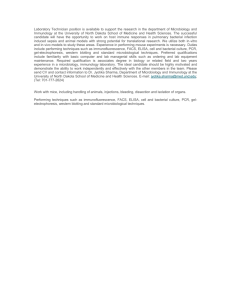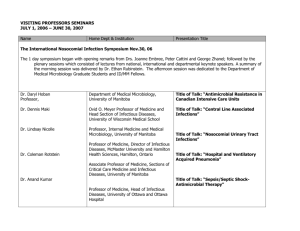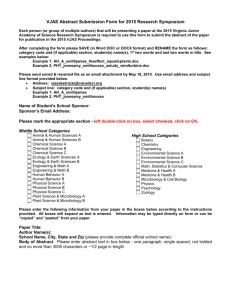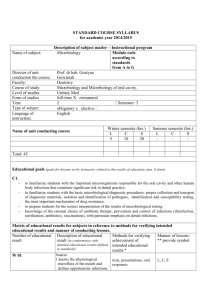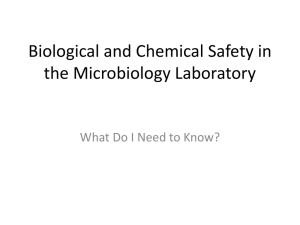6md microbiology syllabus 2015_2016
advertisement
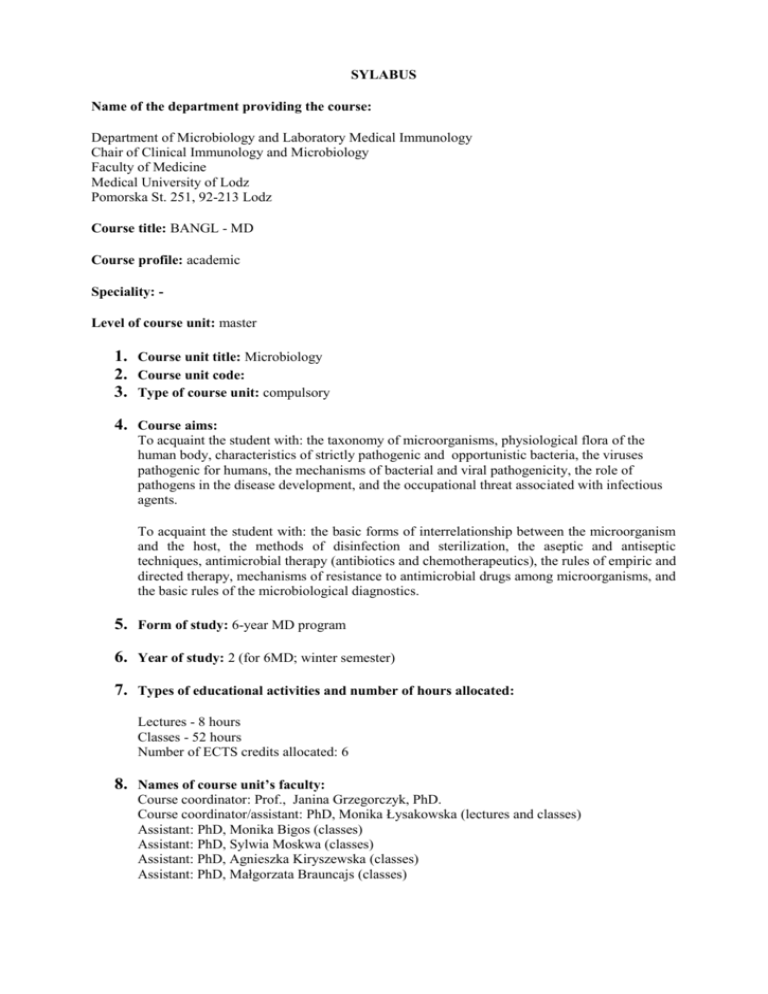
SYLABUS Name of the department providing the course: Department of Microbiology and Laboratory Medical Immunology Chair of Clinical Immunology and Microbiology Faculty of Medicine Medical University of Lodz Pomorska St. 251, 92-213 Lodz Course title: BANGL - MD Course profile: academic Speciality: Level of course unit: master 1. Course unit title: Microbiology 2. Course unit code: 3. Type of course unit: compulsory 4. Course aims: To acquaint the student with: the taxonomy of microorganisms, physiological flora of the human body, characteristics of strictly pathogenic and opportunistic bacteria, the viruses pathogenic for humans, the mechanisms of bacterial and viral pathogenicity, the role of pathogens in the disease development, and the occupational threat associated with infectious agents. To acquaint the student with: the basic forms of interrelationship between the microorganism and the host, the methods of disinfection and sterilization, the aseptic and antiseptic techniques, antimicrobial therapy (antibiotics and chemotherapeutics), the rules of empiric and directed therapy, mechanisms of resistance to antimicrobial drugs among microorganisms, and the basic rules of the microbiological diagnostics. 5. Form of study: 6-year MD program 6. Year of study: 2 (for 6MD; winter semester) 7. Types of educational activities and number of hours allocated: Lectures - 8 hours Classes - 52 hours Number of ECTS credits allocated: 6 8. Names of course unit’s faculty: Course coordinator: Prof., Janina Grzegorczyk, PhD. Course coordinator/assistant: PhD, Monika Łysakowska (lectures and classes) Assistant: PhD, Monika Bigos (classes) Assistant: PhD, Sylwia Moskwa (classes) Assistant: PhD, Agnieszka Kiryszewska (classes) Assistant: PhD, Małgorzata Brauncajs (classes) 9. Prerequisites: Medical biology, biochemistry, physiology, and molecular biology courses should be passed. 10. Learning activities and teaching methods: lectures and laboratory activities (classes) 11. Course unit content: Lectures: 1. Introduction to microbiology. 2. Pathogenicity of microorganisms. 3. General virology. 4. HIV, Influenza virus. Classes: 1. General microbiology – bacteriological media, methods of the microbiological inoculation and cultivation, preparation of pure cultures, the structure of the bacterial cell, staining methods of the bacterial slides 2. General microbiology – bacteria present in the environment and in the human body. The influence of the physical and chemical factors on bacteria. 3. General microbiology – antibiotics and chemotherapeutics. 4. General microbiology – I. Vaccines. II. The sampling, and the storage of the biological material; The transport of samples to the microbiological laboratory. 5. Virology – principles of diagnostics. TEST NO 1. 6. Skin infections. 7. Infections of the respiratory system. 8. Infections of the digestive tract. Food poisoning. 9. Urogenital infections. TEST NO 2. 10. Sexually transmitted diseases. 11. Infections of the nervous system. 12. Bloodstream infections. Zoonoses. 13. Hospital acquired infections. TEST NO 3. 12. Course objectives: Knowledge: The student: C.W11. knows the genetic mechanisms of resistance to antimicrobial agents among microorganisms; C.W12. knows the taxonomy of the commensal and pathogenic microorganisms; C.W13. knows the epidemiology of infections caused by the viruses and bacteria, including their geographical coverage; C.W14. knows the influence of the abiotic and biotic (bacteria and viruses) environmental agents on the human organism and the human population, the modes of their transmission to the host; is able to describe the consequence of exposure to various chemical and biological factors, and the rules of prophylaxis; C.W17. knows the signs and symptoms of iatrogenic infections, the modes of their transmission, and the pathogens infecting the particular internal organs of the human body; C.W18. knows and understands the basics of the microbiological diagnostics; C.W19. knows the basics of disinfection, sterilization, and aseptic techniques; C.W20. knows the process of development and the activity of the immunological system, including nonspecific and specific mechanisms of the immunological response (humoral and cell-mediated immunity); C.W26. knows the main mechanisms of the cell and tissue destruction during the infectious process; C.W28. knows the definition of shock and its pathophysiology (is able to differentiate between SIRS, sepsis, septic shock, MODS); C.W32. is able to present the list of pathogenic factors (external and internal, alterable and non-alterable); C.W38. knows the main side-effects of the antimicrobial therapy, including interactions between various antimicrobial agents; C.W39. understands the phenomenon of resistance to antimicrobial drugs, including multidrug resistance; Skills: The student: C.U9. is able to prepare the microscopic slides and recognize the pathogens under the microscope; C.U10. can interpret the results of the microbiological diagnostics; C.U15. is able to plan the scheme of the rational antimicrobial therapy (empiric or directed); After the microbiology course the student is able to: describe the structure of the bacterial cell and the viral particle, including the biological differences between them; - list and characterize the bacterial and viral species being the main etiological factors of the human infections; - explain the meaning of the following terms: reservoir of the pathogen, source of infection, modes of transmission, and the portals of entry for the infectious agents; - describe the components and the application for the various vaccines and antiserum; - find the correlation between the signs and symptoms of the given infectious disease and the view of the destroyed tissue and internal organs (on the basis of the physical examination of the patient and the results of the laboratory diagnostics); - describe the consequences of the pathologic changes in various internal and external organs of the human body, and analyze the response of the human organism to destructive activity of the pathogen. Attitudes and transferrable (generic) competencies: The student: - is able to make his/her own self-assesment of the skills and knowledge - is interested in improving the skills and widening the knowledge - is able to work as the member of the group and play various roles in this group - is awake to his/her responsibility for his/her safety, and the safety of the environment, including the co-workers. - 13. Required and recommended learning resources (readings): Required: Goering R.V., Dockrell H. M., Zuckerman M., RoittI. M., Chiodini P. L.: „Mims’Medical Microbiology”. 5th edition. Elsevier, 2012. ISBN: 9780723436010. Harvey R. A.: “Lippincott’s Illustrated Reviews: Microbiology”. 3rd edition. Wolters Kluwer Health/Lippincott Williams & Wilkins, 2013. ISBN: 13 978-1-608-317332. Recommended: Brauncajs M., Krzemiński Z.: Medical Microbiology – Microscopic Slides and Media” (pdf); http://studymed.umed.pl/downloads-2/ Tilton R. C.: „Microbiology. PreTest USMLE step 1”. 10th edition and any next. McGraw-Hill, 2002. DOI: 10.1036/0071389709. 14.Assessment methods and criteria: Microbiology Course – Regulations for Students: I. Regulations and Laboratory Safety Rules are presented to students at the beginning of the Microbiology Course and have to be strictly obeyed. Each student confirms his knowledge of them by a personal signature. II. Students take part in lectures and compulsory classes in groups and on days according to the given schedule. Students must be punctual. III. Each student may miss maximum 3 classes and the absences should be justified. Otherwise, the student has to repeat the Microbiology Course next academic year. IV. Students are obliged to keep a copybook and have color pencils to make clear and legible notes and drawings from the practical part of each class. The instructor may check the notes after the class. V. A white coat is obligatory. If the student has no got it, it is synonymous with being not prepared for the class. A student cannot take part in the quiz and class, and it is treated as absence. There is no possibility to borrow a white coat in our Department. VI. The student has to be theoretically prepared for each class (information published on the website of the MUL in bookmark http://studymed.umed.pl/downloads-2/.). Student’s knowledge is graded on each class (written answers-quiz). From each quiz the student can get three small points due to answering correctly to three questions. Each answer is graded for 0, 0.5, or 1 point. Therefore the student may get maximum 3 “small points” from one class (10 such quizzes are scheduled; maximum 30 points). Quizzes cannot be repeated, e.g. if a student was absent or late (regardless of the reason). The student is obliged to know the whole material mentioned in the Syllabus and Microbiology Outline even if some issues were not touched on by the instructor. VII. A series of classes finish with the colloquium built of 10 questions (answers in a written form or multiple choice test). Three such tests are scheduled (I. Classes 1-4; II. Classes 5-8; III: Classes 9-12). One basic attempt and two retakes for each test are scheduled. The student can obtain maximum 20 points from each colloquium (minimum to pass: 11 points). Non-excused absence on the colloquium, or non-accession to the colloquium results in the loss of time limit and obtain the mark failed. The sick leave certificate confirmed in the book of health of the student must be presented, at the latest, within five working days after the underlying circumstances occurred. Colloquium mark: 0-10 points – 2 (failed) 11-12 points – 3 (sufficient) 13-14 points – 3+ (satisfactory) 15-16 points – 4 (good) 17-18 points – 4+ (very good) 19 – 20 points – 5 (excellent) VIII. Appropriate behavior has to be obeyed during the tests and exams. Talking, cheating, and using mobile phones and other electronic equipment (even as a watch) are forbidden! Otherwise, the student has to leave the class. Information of the blameworthy behavior is submitted to the Dean. IX. To be prepared for the classes, tests, and exams, the student is obliged to use the recommended textbooks and instructor materials. X. Only the classic wooden pencils (not propelling pencils!) should be used for the quizzes, colloquia, and tests. XI. The Term Credit will be given to students, who: a) passed three colloquia assigned for the term b) obtained 50% of points from tests and quizzes altogether (45 points). If the student did not manage to do that before the Exam Session, he gets 2.0 (failed) from the 1st attempt of the Final Exam and he has to complete it before the Retake Exam I (two retakes for each missing test). Otherwise, he has to repeat the whole Microbiology Course next academic year. XII. The Final Exam takes the form of the multiple choice test – (80 questions with five possible answers (one best answer), it will last 1 hour and 30 minutes). Retake Exam I and Retake Exam II are also multiple choice tests. Non-excused absence on the examination results in the loss of one from three time-limits and obtain the mark failed. The sick leave certificate confirmed in the book of health of the student must be presented, at the latest, within five working days after the underlying circumstances occurred. The Final Mark: 74-80 68-73 62-67 55-61 48-54 0- 47 points: 5.0 (excellent) points: 4.5 (very good) points: 4.0 (good) points: 3.5 (satisfactory) points: 3.0 (sufficient) points: 2.0 (failed) Additional information: janina.grzegorczyk@umed.lodz.pl; monika.lysakowska @umed.lodz.pl 15.Statement and signature of the course leader: I hereby state that the content of the curriculum included in the syllabus below is the result of my individual work completed as part of work contract/cooperation resulting from a civil law contract, and that author rights to this title are not the property of a third party. 16.Dean’s signature: 17.Date: The following basic Safety Rules should be observed at all times in the laboratory: 1. Before entering the laboratory, place all your things you do not need during classes (coats, bags etc.) in the cloak-room. You need to have 2x2 zł (cloakroom downstairs for clothes and big bags; cabinets near classrooms for handbags or laptops).You can take only necessary things (your notes, color pencils, etc.) to the classroom. Only these stationeries can be placed on bench tops. An appropriate pen for writing on the glass is also necessary. 2. Wear a laboratory coat or apron while working in the lab to protect clothing from contamination or accidental discoloration by staining solutions. You are not allowed to take part in classes if you have not got a lab coat. The laboratory shoes are also obligatory. 3. Keep doors and windows closed during the laboratory session to prevent contamination from air currents. 4. Remember that you work with alive and virulent bacterial cultures. Do not place contaminated instruments, such as inoculating loops, needles, and pipettes, on bench tops. Loops and needles should be disposed of in designated containers. 5. On completion of the lab session, place all cultures and materials in the disposal area as designated by the instructor. 6. Wash your hands with liquid or solid detergent and dry them with paper towels upon entering and prior to leaving the lab. 7. Tie back long hair to minimize its exposure to open flames. Closed shoes should be worn at all times in the lab setting. 8. Do not smoke throughout all Departments. Do not eat, or drink in the laboratory. Never apply cosmetics or insert contact lenses in the laboratory. 9. Carry cultures carefully if you have to move around the laboratory. Likewise, keep cultures on the bench tops when not in use. This serves a dual purpose: to prevent accidents and to avoid contamination of yourself and the environment. 10. Never remove media, equipment, or bacterial cultures from the laboratory. Doing so is absolutely prohibited! 11. If an infectious material is poured over on the table, floor, a lab coat, etc., your instructor (who will disinfect it properly) must be called instantly! You can cover it with paper towels and saturate with disinfectant solutions. After 15 min. of reaction time, remove the towels and dispose of them in a manner indicated by the instructor. 12. Report accidental cuts or burns to the instructor immediately. 13. Speak quietly. Work in a laboratory requires concentration, accuracy, and caution. Otherwise, you may be asked to leave the class what is synonymous with absence. 14. Avoid unnecessary movement around the laboratory to prevent distractions that may cause accidents. 15. Immediate hand washing is required if contact with any of contaminated materials occurs. 16. After classes your work-place must be cleared (turn off the burner, wipe the microscope objective lens, place the bottles with dyes etc.). Before leaving the lab, wash your hands carefully using soap and disinfectant, if necessary.
